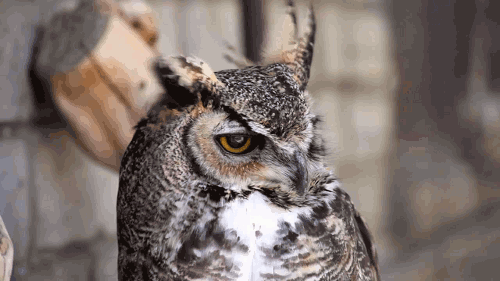HI HORNED OWLS

The facial disc is rusty-brown to ochre-buff, paler around the eyes, with a prominent blackish rim on each side. Eyes are yellow, with blackish edged eyelids. The bill and cere are greyish. Eyebrows are prominent and whitish. Ear-tufts are long and tousled. Tarsi and toes are densely feathered, with just a small zone at the end of the toes bare, and coloured greyish-brown. Claws are dark horn with blackish tips. General colouration varies individually.
Length 45-63.5cm. Wingspan 91-152cm. Tail length 175-250mm. Weight 900-2503g. Females are 10-20% larger than males. Activity generally begins at dusk, but in some regions, may be seen in late afternoon or early morning. Both sexes may be very aggressive towards intruders when nesting. Great Horned Owls have adapted to many different places and climates. They occur in habitats from dense forests, deserts and plains to city parks. They have been known to inhabit the same area as the diurnal red-tailed hawk. Great Horned Owls are found throughout North America from the northern treeline and then in Central and South America. They are resident year-round, however, birds living in the northern part of the species' range may migrate south.
Great Horned Owls have a large repertoire of sounds, ranging from deep booming hoots to shrill shrieks. The male's resonant territorial call "hoo-hoo hoooooo hoo-hoo" can be heard over several kilometres during a still night. Both sexes hoot, but males have a lower-pitched voice than females. They give a growling "krrooo-oo" or screaming note when attacking intruders. Other sounds include a "whaaa whaaaaaa-a-a-aarrk" from disturbed birds, a catlike "MEEE-OWww", barks, hair-raising shrieks, coos, and beak snapping. Some calls are ventriloquial. Most calling occurs from dusk to about midnight and then again just before dawn.
← IM DONE READING